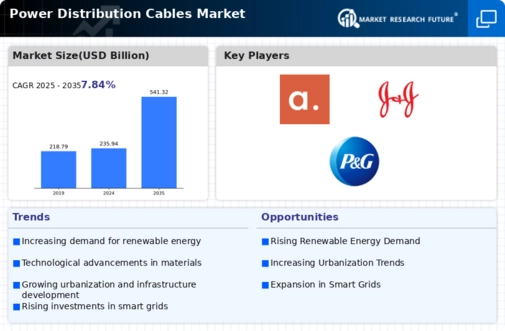Market Analysis
In-depth Analysis of Power Distribution Cables Market Industry Landscape
The Power Distribution Cables market is influenced by a multitude of factors that collectively shape its growth and dynamics. One of the primary drivers for this market is the increasing global demand for electricity and the expansion of power generation and distribution infrastructure. As urbanization and industrialization continue, the need for reliable and efficient power distribution systems rises, driving the demand for power distribution cables. These cables serve as essential components in transmitting electricity from power plants to various end-users, including residential, commercial, and industrial sectors.
Technological advancements play a pivotal role in shaping the Power Distribution Cables market. Ongoing research and development efforts focus on improving the design, materials, and performance characteristics of power cables. Innovations such as high-temperature superconductors, advanced insulation materials, and smart grid integration contribute to the market's evolution. Manufacturers strive to develop power distribution cables that not only meet stringent industry standards but also address the increasing demand for energy efficiency and sustainability.
Market factors are closely tied to the broader energy landscape and the expansion of renewable energy sources. As the world transitions towards cleaner energy options, the integration of renewable power generation requires efficient and reliable power distribution systems. Power distribution cables facilitate the transmission of electricity generated from renewable sources to the grid, supporting the global shift towards sustainable energy practices.
The regulatory environment significantly impacts the Power Distribution Cables market. Government policies, safety standards, and environmental regulations drive the adoption of advanced cable technologies in power transmission and distribution networks. Compliance with these regulations is essential for cable manufacturers to ensure the reliability and safety of power distribution systems. As regulations evolve, the demand for innovative power distribution cables that meet both performance and environmental standards is expected to grow.
Economic conditions and infrastructure development are essential factors influencing the Power Distribution Cables market. Economic growth and increased investments in infrastructure projects contribute to the demand for power cables in expanding power grids. Conversely, economic downturns may temporarily slow down infrastructure investments, impacting the market's growth. The pace of urbanization and electrification in emerging economies also significantly influences the demand for power distribution cables.
Competitive dynamics and the presence of key market players play a crucial role in shaping the Power Distribution Cables market. The industry is characterized by strong competition among cable manufacturers, each striving to differentiate themselves through technological innovation, cost-effectiveness, and reliability. Strategic partnerships, collaborations, and mergers contribute to market consolidation and the development of advanced power distribution cable solutions.
Environmental considerations and the global push towards sustainable infrastructure also impact the market. As governments and industries prioritize environmentally friendly solutions, power distribution cables are expected to meet higher efficiency standards and contribute to reducing energy losses during transmission. Manufacturers are focusing on developing cables with improved insulation materials and transmission efficiency, aligning with the broader trend of adopting eco-friendly technologies.
The evolution of smart grids and digitalization in the power sector are additional factors influencing the Power Distribution Cables market. As power distribution systems become more advanced and interconnected, the demand for cables with enhanced data transmission capabilities and compatibility with smart grid technologies increases. Power distribution cables must adapt to the changing requirements of modern grid infrastructures, supporting the integration of digital monitoring and control systems.
Supply chain dynamics and the availability of raw materials impact the Power Distribution Cables market. Manufacturers need to secure a stable supply of materials such as copper and aluminum for producing power cables. Any disruptions in the supply chain can affect production schedules and the availability of cables for power distribution projects.
In conclusion, the Power Distribution Cables market is influenced by a combination of technological, regulatory, economic, competitive, and environmental factors. As the demand for electricity continues to grow globally and the energy landscape undergoes transformations, power distribution cables remain critical components for ensuring reliable and efficient power transmission. The market is expected to witness further advancements as manufacturers respond to changing industry requirements and contribute to the development of sustainable and resilient power distribution systems.






Leave a Comment